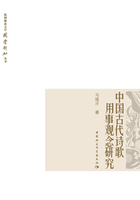
Study on the Concept of Yongshi ofAncient Chinese Poetics
Yongshi(用事,allusion or quatation)is an writing skill of ancient Chinese poetry.It is also an important and unique proposition of ancient Chinese poetics.It brings elegant and implicative characteristic into ancient Chinese poetry through making semantic analogy between what the poetry describes and the allusions quoted.
Ancient poeticstheorists always keep their minds on the definition,status,rules and acceptance of Yongshi and so on.They left behind a rich poetics theoretical heritage for us.And they are not only the organic components of ancient Chinese poetics,but also the important contents of poetics works such as Shige(诗格,the model of poem),Shihua(诗话,talk about poem)and Shifa(诗法,skill of poetry).If we don't understand Yongshi,we will lose some precious traditional concept and valuable experiences of poertry creation.Moreover,Yongshi provides us a new perspective for understanding ancient Chinese poetics and history deeply.
The ancient criticism on Yongshi was scattered in various types of Chinese poetic works.It is necessary for us to collect and sort out the literatures of criticism from many ancient books.Since the beginning of the 20thcentury,the researchers of rhetoric and literary fields began to make study on Yongshi.But these studies are not deep and systematic due to the long- time prejudice and contempt on literary art forms.So,this paper aims at making a systematic study on Yongshi skills and the criticism on Yongshi of ancient Chinese theorists.It consists of seven chapters.A brief introduction is given of this paper as follow:
Chapter 1 concerns Yongshi with definition,writing skills,origins in ancient Chinese poetics.The term Yongshi can be used in a broad and a narrow sense.Its broad meaning is similar with Shilei(事类,referece similar stories)and Yongdian(用典,reference)that refers to cite the ancient story or words.Its narrow meaning the ancient Chinese poets often used mainly refers to cite the stories that took place previously.Most of poets commonly used four skills of Yongshi.In addition,ancient poetics theorists discussed the origins of the Yongshi.Some of them believed that the origin of Yongshi is Book of Poetry(《诗经》)or Li Sao(《离骚》).Others thought that the origin of Yongshi is originated from Liang(梁)Dynasty.
Chapter 2 inspected the status of Yongshi in the mind of ancient poetics theorists.Some of them believed Yongshi is favorable to convey thoughts and feelings of poets.Yongshi is given a higher status by them.On the contrary,from the beginning of Nan Dynasty,many ancient poetics theorists argued that Yongshi is harmful to freely express feeling of poets.So,they opposed using Yongshi in poetry.However,most ancient poetics theorists trusted that poets could enhance artistic charm of poetry if only they used Yongshi properly in writing poetries.But if poets use Yongshi wrongly,it will lead to the obscure meaning of poetry.So,people should concern with the way of Yongshi,instead of discussing whether the poets need to use Yongshi in writing poetries.
Chapter 3 summarizes four appraisal standards of ancient poetics theorists on Yongshi.First,the most important is that there must be some similarities between what the poetry described and the allusions been quoted.Second,the poets should integrate Yongshi skills and poetic contents.Third,the poets should use allusions in a more flexible way,not just arranging them purposely.Fourth,poets should avoid using familiar or vulgar allusions.
Chapter 4 inspected the rules established by ancient poetics theorists on Yongshi.First,they don't think the poets should use familiar or obscure allusions.Second,ancient poetics theorists thought that poets should use allusions before the Tang Dynasty and avoid using contemporary allusions.Third,ancient poetics theorists prescribe literature source of Yongshi.Most of them thought po-ets should use allusions of the classical historical documents and the Confucian works.
Chapter 5 mainly discusses constraints of Yongshi on poetic subjects and forms of content.According to different subjects,the poet should use corresponding allusions.In addition,we found the forms of Lushi has limitation on Yongshi.
Chapter 6 mainly discusses some necessities for authors and readers when they face the allusions.As for authors,it is important for them to accumulate all kinds of knowledge and learn to how to apply it properly in writing poetries.The outstanding poets never gain knowledge only through reading Leishu(类书).On the other hand,a qualified reader should possess sufficient knowledge and interpretive skills in order to understand the meaning of poetries.They must overcome two mistakes as follows:first,the failure to identify the allusions of poetries.Second,exceeding interpretations leads to misunderstand.
Chapter 7 explains narrative patterns which take Yongshi as the focal point through the discussion on the appraisal to four representative poets of ancient poetics theorists.Moreover,Yongshi undertakes important responsibility for inspecting practical operation of art aesthetic ideal.It provides a new narration perspective for the ancient Chinese literature history.
In addition,this paper has several appendix parts.Appendix I research ancient poetic discussions on Yongshi of Dufu's(杜甫)geye(阁夜)poem.AppendixⅡinterprets the concept of Huyinglin(胡应麟)on Yongshi.AppendixⅢand appendixⅣsupplements the concept of ancient Chinese Ci- poetics(lyric)theorists on Yongshi in Song Dynasty and Qing Dynasty.
Through the discussion on the above aspects,the paper makes a systematic study on the concepts of Yongshi of ancient poetics theory and highlights its important position and meaning in the ancient Chinese poetics.
Key words:Ancient Chinese poetry;Ancient Chinese poetics;Yongshi;Conception;Poetics;Criterion